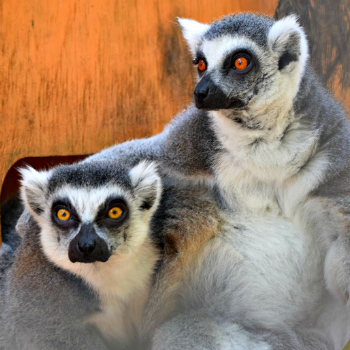About Lemurs
Primarily Primates cares for over 40 lemurs, including ring-tailed, brown and ruffed lemurs. They were rescued from behavioral research, the exotic pet trade and zoos.
Ring-tailed lemurs have gained exposure through movies like IMAX’s Island of Lemurs: Madagascar and the animated kids’ film Madagascar starring King Julien, but what may come as a surprise is there are more than 90 species of lemurs.
Sadly, 94 percent of lemurs are threatened with extinction. Forty-nine species are listed as endangered and another 24 species are critically endangered. Threats include bush meat hunting, the exotic pet trade, loss of habitat from animal farming, logging and wood harvesting, mining and charcoal production and climate change.
There are two main groups of primates: the prosimians and the anthropoids. Lemurs are prosimians. Prosimians means “pre-monkeys” or “early monkeys.” Native only to the island of Madagascar and the neighboring Comoro Islands, lemurs resemble the oldest ancestors of primates who existed tens of millions of years ago. It’s suggested that lemurs made their way to Madagascar from the larger African continent millions of years ago and have since adapted and evolved into the diverse number of species that exist today.

Lemurs do not have prehensile tails (they cannot hang by their tails from trees like monkeys), but they do have long, wet noses. While their thumbs and big toes are opposable, they mainly use their teeth and an extended “toilet claw” on the second toe of their hind feet for grooming.
Most lemurs are also diurnal, awake during the day and asleep at night — especially those that live in groups, including the ring-tailed lemurs and brown lemurs. The brown lemurs at PPI share a habitat with our ring-tailed lemurs. Mixed species sharing a habitat can be a great form of socialization because it adds a different social dynamic to the troop. PPI’s lemurs are extremely social, so much so that you often see them huddled together in a “lemur ball.”
Speaking of social dynamic, another remarkable thing about lemurs is most species live in a matriarchal society—one dominant female leads the group, controls their movement and has first choice of mates and food.
And don’t let their size fool you—while their brain mass might be small, they are extremely intelligent. The lemurs at PPI can recognize sequences and patterns sometimes faster than the great apes. For example, when given food enrichment puzzles, they use problem solving skills to determine what lever releases which treat, and they always go for the lever that releases the fruit treat first.
The lemurs also seem to have figured out when food enrichment days are—their level of excitement and activity amp on those days before the treats are passed out. To keep them sharp, PPI changes the days our caregivers present food enrichment because lemurs would experience change every day in the wild.

